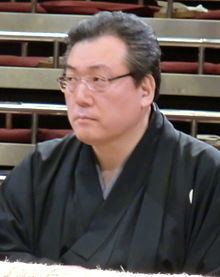Record 387-321-86 Championships 5 (Juryo) Height 1.88 m Debut March, 1979 Name Masurao Hiroo Weight 119 kg | Role Sumo Wrestler Spouse Hisako Okumura Retired July, 1990 Makuuchi rank Sekiwake | |
 | ||
Special Prizes Outstanding Performance (2)Fighting Spirit (2)Technique (1) Stable Oshiogawa stable (1979–1990) Similar People Daijuyama Tadaaki, Tochitsukasa Tetsuo, Wakakoyu Masaya, Takamisugi Takakatsu, Kotogaume Tsuyoshi | ||
Highest rank Sekiwake (July, 1987) | ||
Masurao Hiroo (益荒雄広生, born June 27, 1961) is a Japanese former sumo wrestler, born Hiroo Teshima (手島 広生, Teshima Hiroo) in Itoda, Fukuoka Prefecture. Making his professional debut in 1979, he reached the top division in 1985. His highest rank was sekiwake and he won five special prizes in his top division career. He was one of the lightest wrestlers in the top division, and very popular with tournament crowds. In his later career he suffered from a number of injuries, particularly to his knee, and he retired in 1990 at the age of 29. He is now the head coach of Ōnomatsu stable.
Contents

Career

In his youth he excelled at judo but was persuaded to give sumo a try by Oshiogawa Oyakata, the former ōzeki Daikirin. He entered sumo after his second year of high school, and fought his first match, under the name Tejima, at age 17 in the March tournament of 1979. In 1985 he entered the makuuchi ranks, having already taken the name Masurao. He won his first special prize in November 1986, and his first kinboshi in January 1987.
The March tournament of 1987 saw Masurao ranked in the titled san'yaku ranks for the first time, at komusubi. In the first seven days he defeated two yokozuna (Chiyonofuji and Futahaguro) and four ōzeki (Hokuten'yū, future yokozuna Ōnokuni, Asashio, and Wakashimazu). Despite these six victories over higher-ranked opponents, he began losing in the second week and ended the tournament with a 9-6 record. In the next basho in May he beat two more yokozuna (Chiyonofuji and, for the third time in a row, Futahaguro) and two more ōzeki and scored 10-5. He then advanced to sekiwake, the highest rank he attained. However he finished the July 1987 tournament with a 4-11 record and never made sanyaku again. In the following September tournament he injured his knee in a bout with Onokuni and was forced to withdraw, falling to the bottom of the division. In May 1988 he injured the knee again in a bout with another heavyweight, Konishiki, and ended up dropping out of that tournament too. His knee continued to trouble him for the rest of his career, and he was demoted to the second jūryō division on several occasions. He ended up winning the jūryō division championship five times, which is a record.
Masurao retired from wrestling in July 1990 at the age of just 29. He left a record of 387 wins, 329 losses, missing 86 bouts. His career spanned eleven years and 68 tournaments, 20 in the makuuchi division, where his record was 111-125-64. He received several honors: the shukunshō twice, the kantōshō twice, and the ginōshō once.
He has the fewest tournaments in the top division of any sekiwake.
Fighting style
Masurao was a yotsu-sumo wrestler, favouring grappling and throwing rather than pushing techniques. His favourite grip on his opponent's mawashi was migi-yotsu, a left hand outside, right hand inside grip. Aside from yori-kiri, or force out, he also regularly used sukuinage, the scoop throw, and shitatenage, the underarm throw.
After retirement
After leaving the ring, Masurao remained in sumo. He is now the head of the Ōnomatsu stable, which he founded in 1994. He has produced five makuuchi wrestlers, Katayama, Wakakōyū, Daidō, Amūru and Ōnoshō. He was forced to leave the Nishonoseki ichimon or group of stables in January 2010 after declaring his support for Takanohana's unsanctioned bid to be elected to the board of directors of the Sumo Association.
